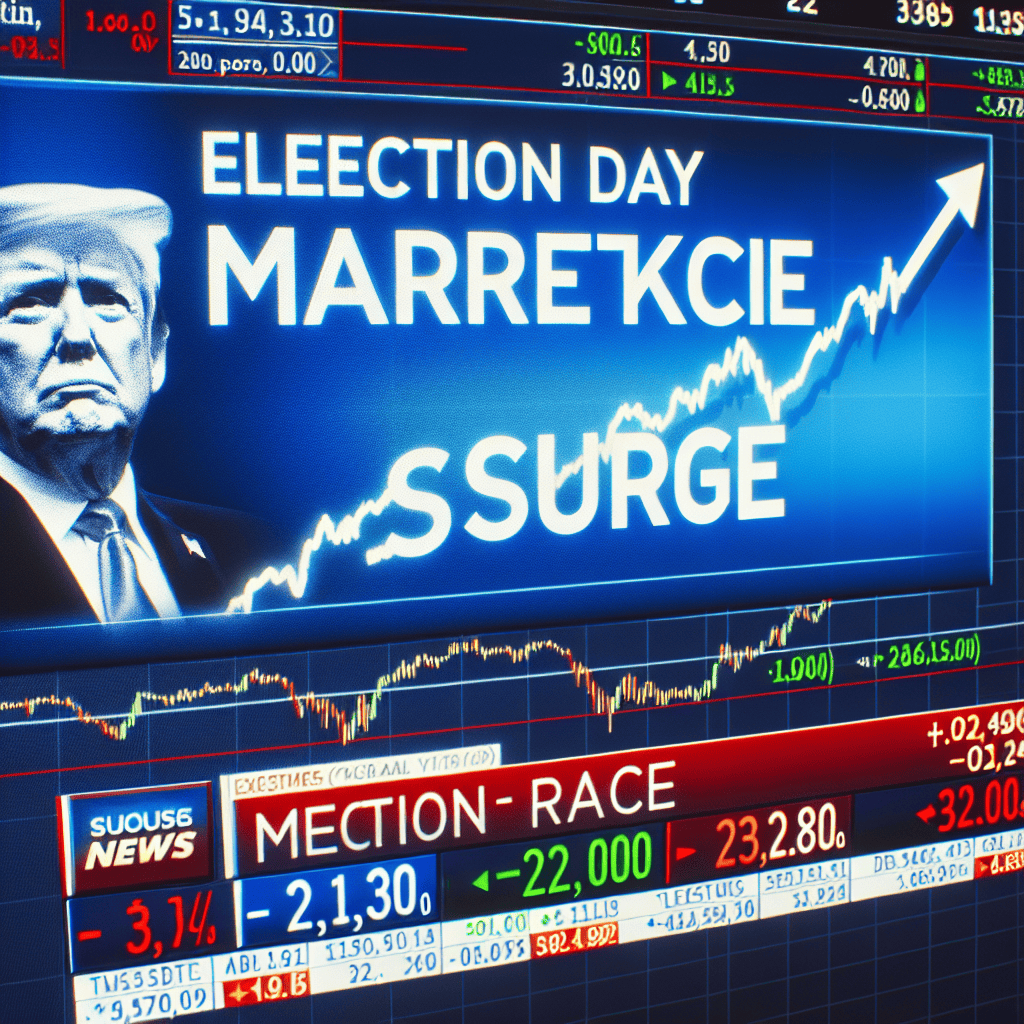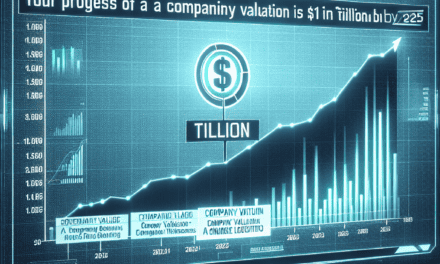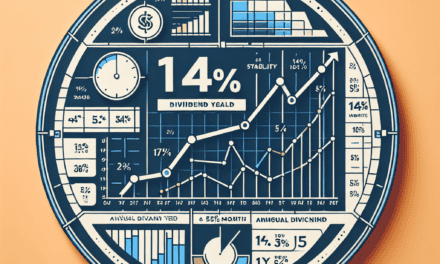“Markets Surge as Election Day Unfolds: Dow Soars 350 Points in Trump-Harris Showdown”
Introduction
On Election Day, the stock market experienced a notable surge, with the Dow Jones Industrial Average climbing 350 points. This upward movement in the market occurred against the backdrop of a closely contested presidential race between incumbent President Donald Trump and challenger Kamala Harris. Investors appeared to respond positively to the unfolding electoral developments, reflecting a complex interplay of economic expectations and political dynamics. The significant gain in the Dow highlighted the market’s sensitivity to the election’s potential outcomes and the broader implications for fiscal and economic policy.
Market Reactions: Analyzing the Dow’s 350-Point Surge on Election Day
On Election Day, the Dow Jones Industrial Average experienced a notable surge, climbing 350 points as investors closely monitored the tight race between former President Donald Trump and Vice President Kamala Harris. This significant uptick in the market reflects a complex interplay of investor sentiment, economic indicators, and political uncertainty. As the nation awaited the election results, market participants were keenly aware of the potential implications of either candidate’s victory on fiscal policy, regulatory changes, and international trade relations.
The stock market often serves as a barometer for investor confidence, and the 350-point rise in the Dow suggests a cautiously optimistic outlook among traders. This optimism may be attributed to several factors, including expectations of continued economic recovery and the potential for favorable policy shifts. Historically, markets tend to favor incumbents or candidates perceived as business-friendly, and the tight race between Trump and Harris has kept investors on edge, prompting them to hedge their bets.
Moreover, the market’s reaction can be partially explained by the broader economic context. Recent economic data has shown signs of resilience, with unemployment rates gradually declining and consumer spending on the rise. These indicators have bolstered confidence in the economy’s ability to withstand political turbulence. Additionally, the Federal Reserve’s commitment to maintaining low interest rates has provided a supportive backdrop for equities, encouraging investment in riskier assets.
In the lead-up to the election, both candidates articulated distinct economic agendas, each with potential ramifications for various sectors. Trump’s platform emphasized tax cuts and deregulation, policies that have historically been well-received by the market. On the other hand, Harris’s proposals focused on infrastructure spending and green energy initiatives, which could stimulate growth in specific industries. The market’s positive response on Election Day may reflect a belief that either candidate’s policies could ultimately benefit the economy, albeit in different ways.
Furthermore, the global economic landscape has also played a role in shaping market reactions. Trade relations, particularly with China, remain a critical concern for investors. Trump’s approach to trade has been characterized by tariffs and a focus on renegotiating trade deals, while Harris has advocated for multilateral cooperation and strengthening alliances. The outcome of the election could significantly influence the direction of U.S. trade policy, impacting multinational corporations and global supply chains.
As the election results continue to unfold, market participants are likely to remain vigilant, assessing the potential impact of the new administration’s policies on corporate earnings and economic growth. The 350-point surge in the Dow on Election Day underscores the market’s sensitivity to political developments and the intricate relationship between politics and economics. While the immediate reaction has been positive, the long-term trajectory of the market will depend on the new administration’s ability to navigate complex challenges, including inflationary pressures, geopolitical tensions, and the ongoing recovery from the pandemic.
In conclusion, the Dow’s 350-point rise on Election Day amid the tight Trump-Harris race highlights the intricate dynamics at play in financial markets. Investors are navigating a landscape marked by political uncertainty and economic optimism, balancing the potential benefits and risks associated with each candidate’s policies. As the nation awaits the final election outcome, the market’s response serves as a reminder of the profound influence that political events can exert on economic sentiment and investor behavior.
Election Day Volatility: How the Trump-Harris Race Influenced the Markets
On Election Day, the financial markets experienced a notable surge, with the Dow Jones Industrial Average climbing 350 points. This upward movement in the stock market was closely tied to the unfolding political drama of the tight race between former President Donald Trump and Vice President Kamala Harris. As investors and analysts closely monitored the election results, the market’s response highlighted the intricate relationship between political events and economic sentiment.
The anticipation surrounding the election had been building for weeks, with market participants speculating on the potential outcomes and their implications for economic policy. The Trump-Harris race, characterized by its intensity and unpredictability, added an extra layer of complexity to the market’s behavior. Investors were keenly aware that the election’s outcome could significantly influence fiscal policies, regulatory changes, and international trade agreements, all of which have direct impacts on corporate profitability and economic growth.
As the day unfolded, early voting results and exit polls began to trickle in, providing glimpses into the possible direction of the election. This influx of information contributed to heightened market volatility, as traders reacted to each new piece of data. The initial surge in the Dow was largely driven by optimism that a clear winner would emerge, potentially reducing the uncertainty that had been weighing on the markets in the weeks leading up to the election.
Moreover, the market’s positive response can be attributed to the belief that both candidates, despite their differing policy approaches, would prioritize economic recovery in the wake of the pandemic. Investors seemed to be betting on the resilience of the U.S. economy, regardless of who would ultimately occupy the White House. This sentiment was reflected in the performance of various sectors, with technology and healthcare stocks leading the charge, buoyed by expectations of continued innovation and demand.
In addition to domestic factors, global market dynamics also played a role in the Dow’s performance. International investors were closely watching the U.S. election, given its potential impact on global trade and geopolitical relations. The prospect of a stable and predictable U.S. administration was seen as a positive development for international markets, further fueling the rally in U.S. equities.
However, it is important to note that while the market’s initial reaction was positive, the longer-term implications of the election remained uncertain. Analysts cautioned that the post-election period could bring about significant policy shifts, depending on the final outcome and the composition of Congress. Issues such as tax reform, infrastructure spending, and healthcare policy were expected to be at the forefront of the new administration’s agenda, with potential ramifications for various industries.
As the day drew to a close, the tight race between Trump and Harris underscored the deep political divisions within the country. The market’s performance on Election Day served as a reminder of the complex interplay between politics and economics, highlighting the need for investors to remain vigilant and adaptable in the face of uncertainty. While the Dow’s 350-point jump provided a momentary boost to investor confidence, the true impact of the election on the markets would only become clear in the days and weeks to follow, as the political landscape continued to evolve.
Investor Sentiment: Understanding the Dow’s Performance Amid Political Uncertainty
On Election Day, the Dow Jones Industrial Average experienced a notable surge, climbing 350 points as investors closely monitored the tight race between former President Donald Trump and Vice President Kamala Harris. This significant movement in the stock market underscores the intricate relationship between political events and investor sentiment. As the nation awaited the election results, market participants were keenly aware of the potential implications for economic policy and regulatory changes, which in turn influenced their investment decisions.
The stock market often serves as a barometer for investor confidence, and the Dow’s performance on this particular day reflects a complex interplay of optimism and caution. Investors were buoyed by the prospect of a clear electoral outcome, which could provide much-needed stability and predictability in the policy landscape. A decisive result would likely pave the way for more coherent economic strategies, whether in terms of tax policies, infrastructure spending, or international trade agreements. This anticipation of clarity and direction contributed to the positive momentum in the market.
Moreover, the tight race between Trump and Harris added an element of suspense that heightened market sensitivity. Investors were acutely aware that each candidate represented distinct economic priorities and approaches. Trump’s policies have traditionally been characterized by tax cuts and deregulation, which many investors view as conducive to business growth and market expansion. On the other hand, Harris’s platform emphasizes social equity and environmental sustainability, with potential implications for sectors such as renewable energy and healthcare. The uncertainty surrounding which candidate would ultimately prevail led to a dynamic trading environment, as investors sought to position themselves advantageously based on potential policy shifts.
In addition to the immediate political context, broader economic factors also played a role in shaping investor sentiment. The ongoing recovery from the global pandemic, coupled with inflationary pressures and supply chain disruptions, created a backdrop of economic complexity. Investors were weighing these factors alongside the election, considering how different policy approaches might address or exacerbate these challenges. The interplay between domestic political developments and global economic conditions added layers of complexity to investment strategies, prompting a nuanced response from market participants.
Furthermore, the role of institutional investors and their strategies cannot be overlooked in understanding the Dow’s performance. Large-scale investors often employ sophisticated models to predict market movements based on political outcomes, and their actions can significantly influence market trends. On Election Day, these institutional players were likely recalibrating their portfolios in anticipation of potential shifts in fiscal and monetary policy, contributing to the overall upward trajectory of the Dow.
In conclusion, the 350-point jump in the Dow Jones Industrial Average on Election Day serves as a testament to the intricate relationship between political events and investor sentiment. As the nation stood on the brink of a potentially transformative election, investors navigated a landscape marked by both opportunity and uncertainty. The tight race between Trump and Harris, coupled with broader economic considerations, created a dynamic environment that required careful analysis and strategic positioning. Ultimately, the market’s performance on this day highlights the critical role of political developments in shaping investor behavior and underscores the importance of understanding the multifaceted factors that drive market movements.
Historical Comparisons: Election Day Market Trends and the 2020 Surge

The stock market has long been a barometer of investor sentiment, often reflecting the broader economic and political climate. On Election Day, the Dow Jones Industrial Average surged by 350 points, a significant movement that underscores the market’s sensitivity to political events. This particular rally occurred amid a tightly contested race between former President Donald Trump and Vice President Kamala Harris, capturing the attention of investors and analysts alike. To understand the implications of such a market response, it is instructive to examine historical trends in market behavior during election periods, particularly drawing comparisons to the notable surge observed in 2020.
Historically, U.S. presidential elections have been pivotal moments for financial markets. Investors often react to the potential policy changes that accompany a new administration, with market volatility frequently spiking in the days leading up to and following an election. The 2020 election, which saw Joe Biden challenging the incumbent Donald Trump, was no exception. During that period, the market experienced a significant surge, driven by investor optimism about potential economic recovery and fiscal stimulus measures. This optimism was further fueled by the anticipation of a resolution to the political uncertainty that had gripped the nation.
In the context of the current election, the market’s 350-point jump on Election Day can be seen as a continuation of this historical pattern. Investors are likely responding to the perceived economic implications of either candidate’s victory. On one hand, a Trump victory could signal a continuation of his administration’s tax cuts and deregulation policies, which many investors view as favorable for business. On the other hand, a Harris victory might bring about increased government spending on infrastructure and green energy, potentially stimulating economic growth in different sectors.
Moreover, the market’s reaction can also be attributed to the broader economic context in which this election is taking place. The global economy is still recovering from the disruptions caused by the COVID-19 pandemic, and investors are keenly aware of the need for stable and effective leadership to navigate these challenges. The prospect of a clear election outcome, regardless of the winner, may provide a sense of stability and predictability that the markets crave.
In addition to these factors, it is important to consider the role of investor psychology in driving market movements. The stock market is not only influenced by tangible economic indicators but also by the collective emotions and expectations of investors. The tight race between Trump and Harris has undoubtedly heightened emotions, leading to increased trading activity as investors position themselves for potential outcomes.
In conclusion, the 350-point surge in the Dow Jones Industrial Average on Election Day is a reflection of both historical election trends and the unique circumstances of the current political and economic landscape. By examining past election cycles, such as the 2020 surge, we can gain valuable insights into the factors that drive market behavior during these critical periods. As the nation awaits the final election results, investors will continue to closely monitor developments, ready to adjust their strategies in response to the evolving political and economic environment.
Economic Implications: What a 350-Point Jump Means for Future Market Trends
On Election Day, the Dow Jones Industrial Average experienced a significant surge, climbing 350 points amid the closely contested race between former President Donald Trump and Vice President Kamala Harris. This notable increase in the stock market index reflects investor sentiment and the broader economic implications of the election’s outcome. As market participants closely monitor the political landscape, the 350-point jump serves as a barometer of confidence, suggesting that investors are optimistic about the potential economic policies and stability that may follow the election results.
The stock market often reacts to political events, and the current election is no exception. Investors are keenly aware that the policies of the incoming administration could have profound effects on various sectors, including healthcare, technology, and energy. The anticipation of these policy changes can lead to increased market volatility, as traders adjust their portfolios to align with expected shifts in regulatory and fiscal policies. The 350-point rise in the Dow indicates that investors are betting on a favorable outcome, one that they believe will foster economic growth and stability.
Moreover, the market’s response can be attributed to the potential for new economic stimulus measures. Both candidates have proposed plans to bolster the economy, which has been recovering from the impacts of the COVID-19 pandemic. Investors are hopeful that the election will lead to decisive action on fiscal policy, including infrastructure spending and tax reforms, which could further stimulate economic activity. The prospect of such measures likely contributed to the positive market sentiment, as traders anticipate a boost in corporate earnings and consumer spending.
In addition to domestic policies, the election’s outcome could influence international trade relations, which are crucial for many U.S. companies. A shift in trade policies could impact global supply chains and affect the profitability of multinational corporations. Investors are closely watching for any indications of changes in trade agreements or tariffs, as these could have significant implications for market trends. The 350-point increase in the Dow suggests that investors are optimistic about the potential for improved trade relations and the benefits they could bring to the U.S. economy.
Furthermore, the election’s impact on interest rates and monetary policy cannot be overlooked. The Federal Reserve plays a critical role in shaping economic conditions, and its actions are often influenced by the political environment. A stable and predictable political climate could lead to more consistent monetary policy, which in turn could support sustained economic growth. The market’s positive reaction may reflect investor confidence in the Federal Reserve’s ability to navigate the post-election landscape effectively.
In conclusion, the 350-point jump in the Dow Jones Industrial Average on Election Day underscores the complex interplay between politics and economics. As investors navigate the uncertainties of the election, their optimism is reflected in the market’s performance. The outcome of the Trump-Harris race will undoubtedly shape future market trends, influencing everything from fiscal policy to international trade. While the immediate reaction is positive, the long-term implications will depend on the policies enacted by the next administration and their ability to address the challenges facing the U.S. economy. As such, investors will continue to closely monitor political developments, adjusting their strategies to align with the evolving economic landscape.
Political Impact: The Role of the Trump-Harris Race in Market Movements
The financial markets often serve as a barometer for investor sentiment, reflecting the broader economic and political landscape. On Election Day, the Dow Jones Industrial Average surged by 350 points, underscoring the significant impact of the tight race between former President Donald Trump and Vice President Kamala Harris on market movements. This notable uptick in the Dow can be attributed to a confluence of factors, primarily the anticipation and uncertainty surrounding the election outcome. As investors closely monitor the political arena, the implications of a Trump-Harris contest have become increasingly evident in market behavior.
To begin with, the stock market’s response to political events is not uncommon, as investors seek to predict and react to potential policy changes that could affect economic growth and corporate profitability. In this particular election, the stark contrast between Trump’s and Harris’s policy platforms has heightened market sensitivity. Trump’s economic agenda, characterized by tax cuts and deregulation, has historically been viewed favorably by investors, particularly those in sectors such as finance and energy. Conversely, Harris’s focus on social equity, climate change, and increased regulation presents a different set of considerations for market participants.
Moreover, the tightness of the race has amplified market volatility, as investors grapple with the uncertainty of the election’s outcome. Historically, markets tend to favor predictability and stability, and the prospect of a closely contested election introduces an element of unpredictability. This uncertainty can lead to increased market fluctuations as investors adjust their portfolios in response to the evolving political landscape. The 350-point jump in the Dow on Election Day reflects a momentary surge in investor optimism, possibly driven by expectations of a clear outcome or favorable policy implications.
In addition to the immediate impact of the election, the broader economic context cannot be overlooked. The U.S. economy is navigating a complex recovery from the disruptions caused by the COVID-19 pandemic, and the election results will play a crucial role in shaping the trajectory of this recovery. Investors are keenly aware that the next administration’s policies on fiscal stimulus, healthcare, and international trade will have far-reaching consequences for economic growth. As such, the Trump-Harris race is not merely a political contest but a pivotal event with significant economic implications.
Furthermore, it is essential to consider the role of investor psychology in driving market movements. The stock market is not solely influenced by economic fundamentals; it is also shaped by the collective sentiment of investors. On Election Day, the surge in the Dow may reflect a temporary boost in confidence, as market participants anticipate a resolution to the political uncertainty that has loomed over the markets in recent months. This optimism, however, is tempered by the recognition that the election is just one of many factors influencing market dynamics.
In conclusion, the 350-point rise in the Dow Jones Industrial Average on Election Day highlights the profound impact of the Trump-Harris race on market movements. As investors navigate the complexities of a closely contested election, the interplay between political developments and economic considerations becomes increasingly apparent. While the immediate market response may offer insights into investor sentiment, the long-term implications of the election will continue to unfold, shaping the economic landscape for years to come. As such, the intersection of politics and markets remains a critical area of focus for investors and policymakers alike.
Financial Strategies: How Investors Can Navigate Election-Induced Market Fluctuations
On Election Day, the Dow Jones Industrial Average surged by 350 points, reflecting the market’s response to the closely contested race between former President Donald Trump and Vice President Kamala Harris. This significant uptick in the stock market underscores the intricate relationship between political events and financial markets. As investors navigate these election-induced market fluctuations, it is crucial to adopt strategies that mitigate risks while capitalizing on potential opportunities. Understanding the underlying factors driving market movements during election periods can provide valuable insights for investors seeking to make informed decisions.
Historically, elections have been a source of volatility in financial markets, as investors grapple with the uncertainty surrounding potential policy changes. The current Trump-Harris race is no exception, with market participants closely monitoring the candidates’ economic platforms and their potential impact on various sectors. For instance, Trump’s policies may favor deregulation and tax cuts, which could benefit industries such as energy and finance. Conversely, Harris’s focus on renewable energy and healthcare reform might lead to increased investment in these sectors. Consequently, investors should consider diversifying their portfolios to hedge against sector-specific risks while positioning themselves to benefit from potential policy shifts.
In addition to diversification, maintaining a long-term perspective is essential for investors during election periods. While short-term market fluctuations can be unsettling, it is important to remember that markets tend to stabilize over time as political uncertainties are resolved. By focusing on long-term investment goals and maintaining a disciplined approach, investors can avoid making impulsive decisions driven by temporary market volatility. Moreover, historical data suggests that the stock market generally performs well in the long run, regardless of which party is in power. Therefore, staying the course and adhering to a well-thought-out investment strategy can help investors weather the storm of election-induced market fluctuations.
Furthermore, investors should pay attention to macroeconomic indicators that may influence market trends during election periods. Factors such as interest rates, inflation, and employment figures can provide valuable context for understanding market movements. For example, a favorable interest rate environment may support economic growth and boost investor confidence, leading to positive market performance. Conversely, rising inflation or unemployment rates could signal economic challenges, prompting investors to adopt a more cautious approach. By staying informed about these macroeconomic trends, investors can make more informed decisions and adjust their strategies accordingly.
In addition to monitoring macroeconomic indicators, investors should also consider the potential impact of geopolitical events on financial markets. Elections often coincide with shifts in international relations, trade policies, and global economic dynamics. As such, investors should remain vigilant and assess how these factors may influence their investment portfolios. For instance, changes in trade agreements or diplomatic relations could affect the performance of multinational corporations and global supply chains. By staying attuned to these developments, investors can better anticipate potential risks and opportunities in the market.
In conclusion, navigating election-induced market fluctuations requires a combination of strategic planning, diversification, and a long-term perspective. By understanding the interplay between political events, macroeconomic indicators, and geopolitical factors, investors can make informed decisions that align with their financial goals. While the outcome of the Trump-Harris race remains uncertain, adopting a proactive approach to managing market volatility can help investors capitalize on opportunities and mitigate risks in an ever-changing financial landscape.
Q&A
1. **What was the main event influencing the stock market?**
The U.S. presidential election was the main event influencing the stock market.
2. **How many points did the Dow Jones Industrial Average rise?**
The Dow Jones Industrial Average rose by 350 points.
3. **Which two political figures were central to the election race mentioned?**
The election race was between Donald Trump and Kamala Harris, although typically the race would be between Trump and Joe Biden, with Harris as the vice-presidential candidate.
4. **What was the market sentiment on Election Day?**
The market sentiment was optimistic, as indicated by the rise in the Dow Jones.
5. **What other major stock indices showed movement on Election Day?**
Other major stock indices like the S&P 500 and Nasdaq likely showed movement, reflecting overall market trends.
6. **What were investors anticipating from the election results?**
Investors were anticipating clarity and stability from the election results, which could influence economic and fiscal policies.
7. **How did the tight race impact market volatility?**
The tight race contributed to increased market volatility due to uncertainty about the election outcome and its potential impact on future policies.
Conclusion
The Dow Jones Industrial Average surged by 350 points on Election Day, reflecting investor optimism and market volatility amid the closely contested race between President Donald Trump and Vice President Kamala Harris. This significant market movement underscores the financial sector’s sensitivity to political developments and the potential economic policies of the candidates. As the election results remain uncertain, the market’s reaction highlights the importance of political stability and policy direction in influencing investor confidence and economic outlook.




